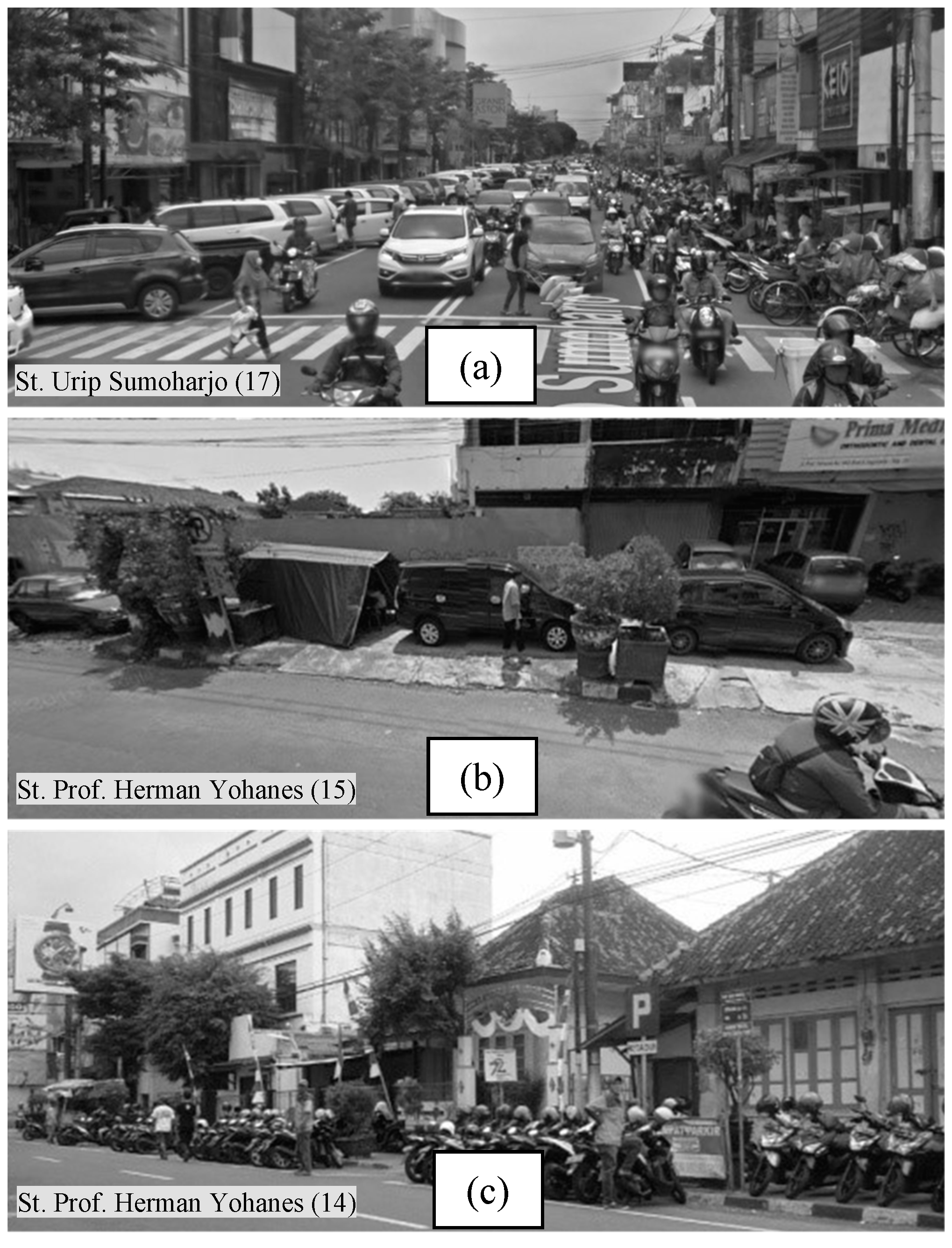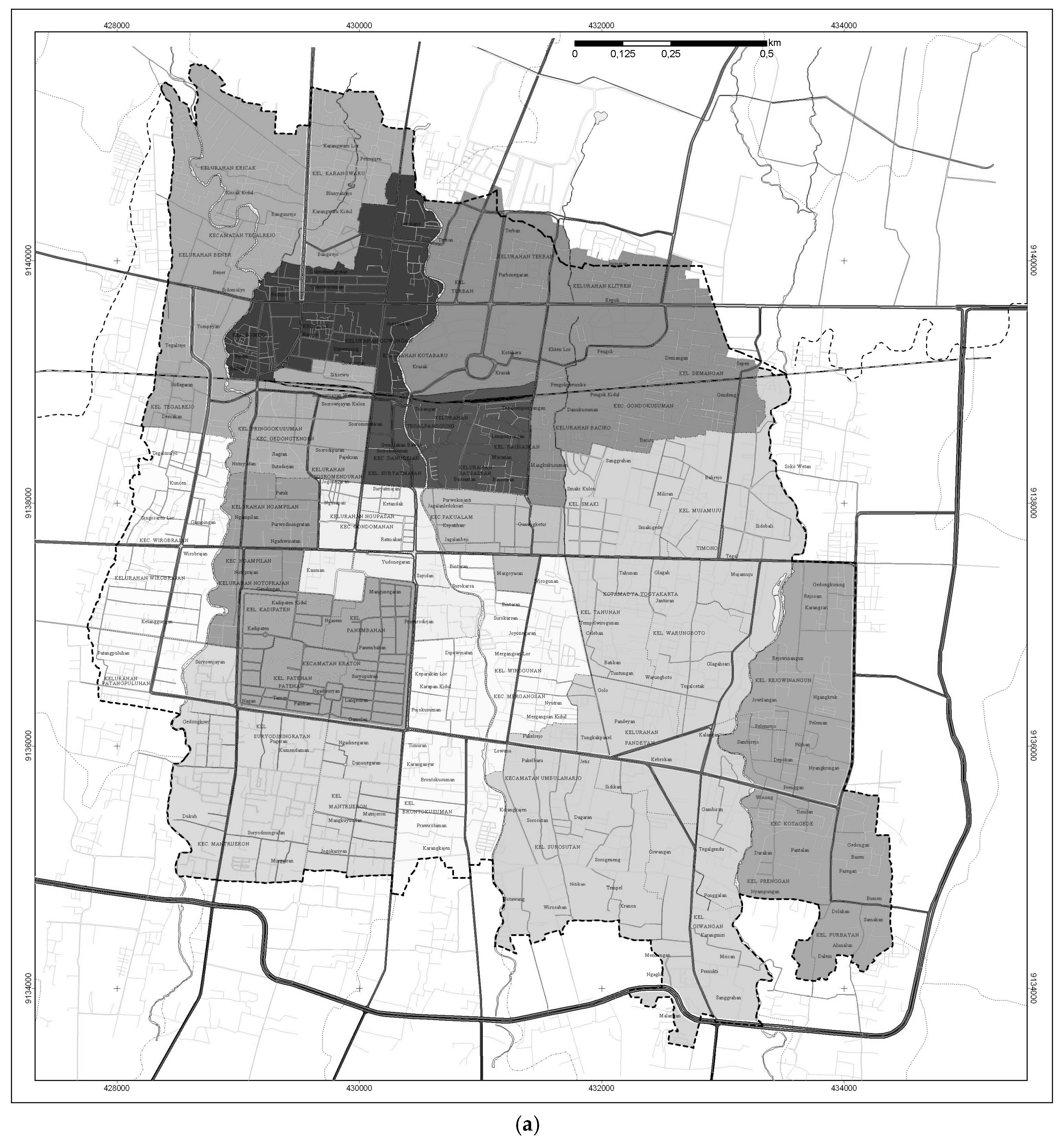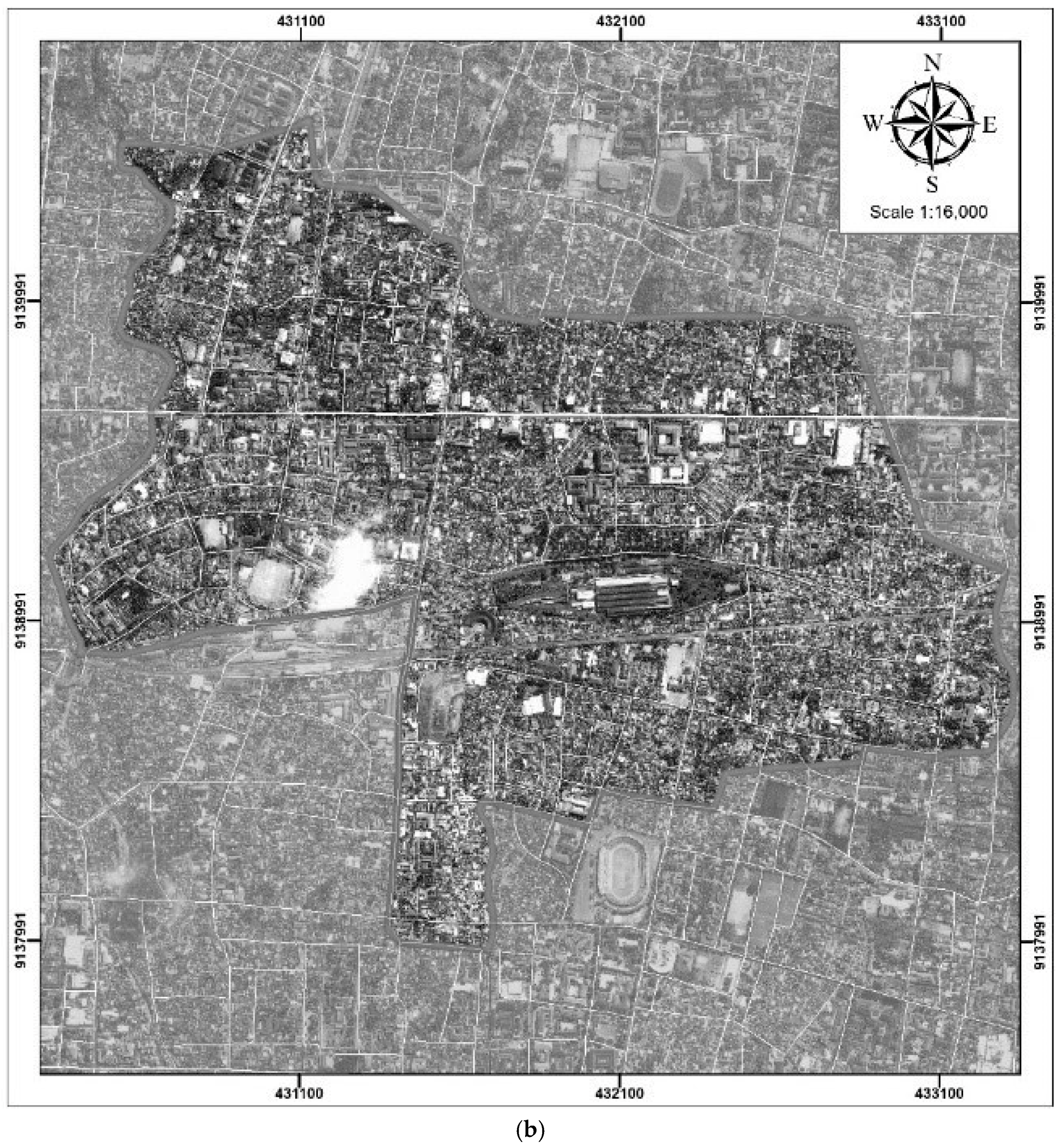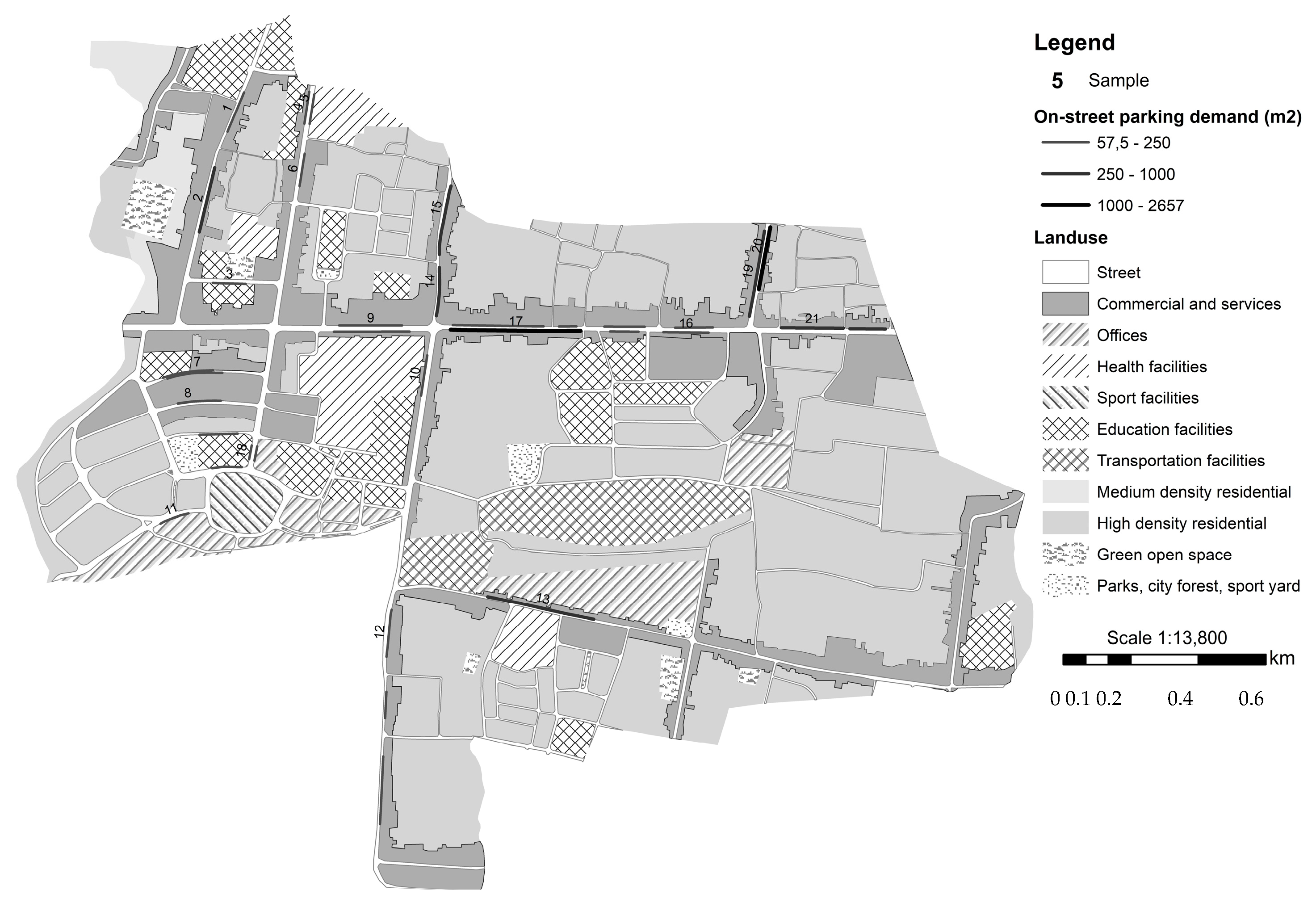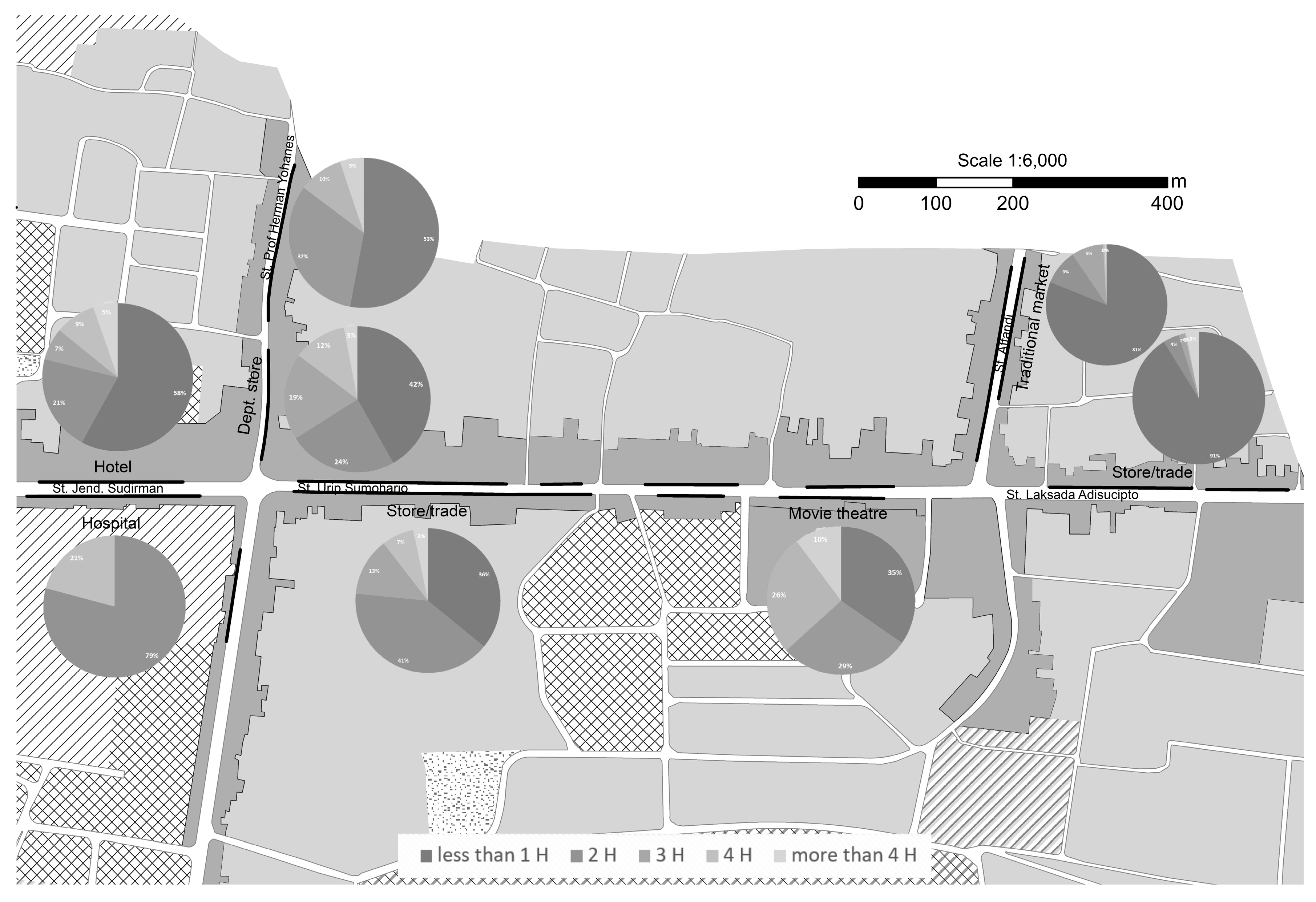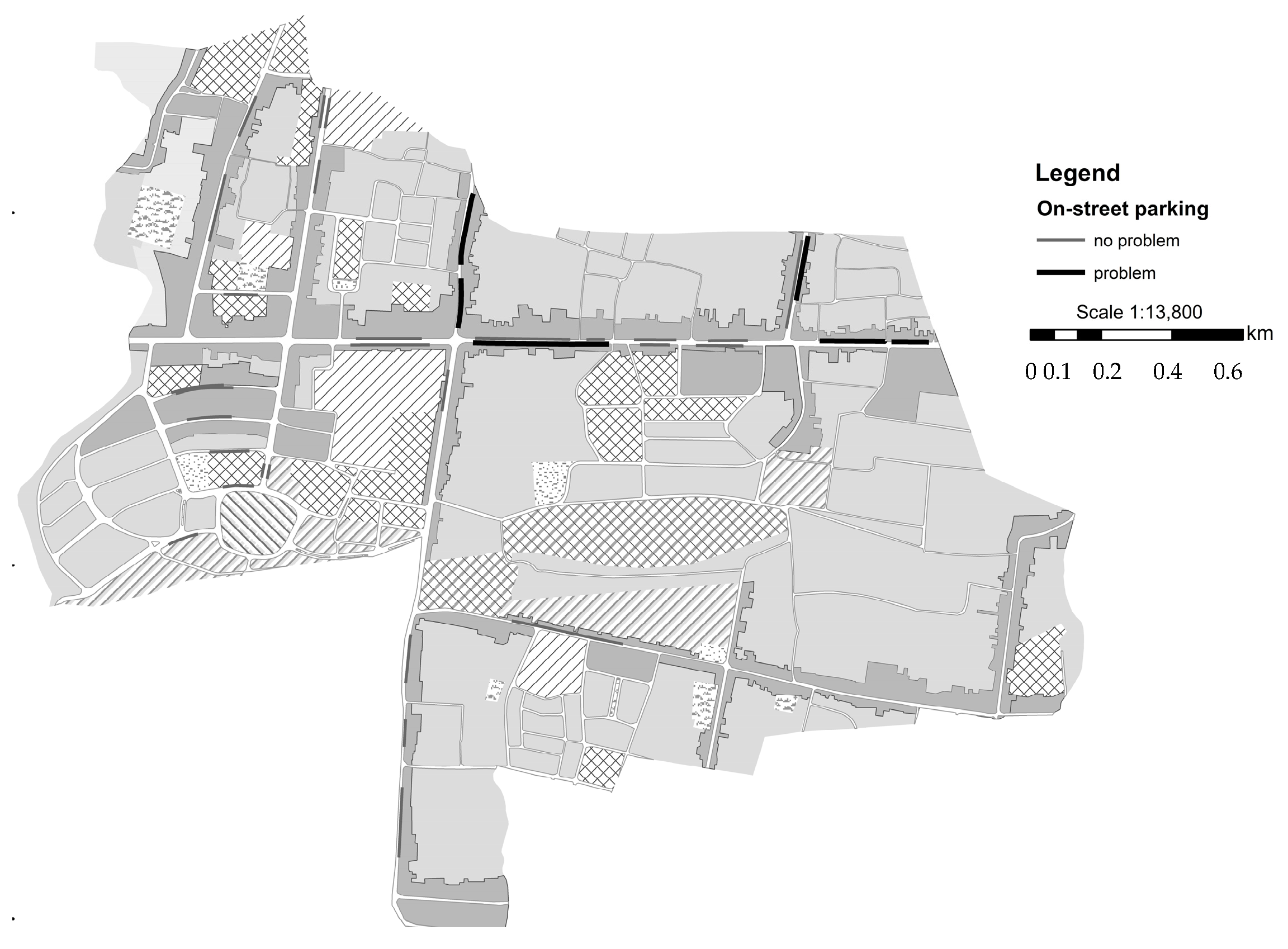3.2. Data and Methods
QuickBird imagery of 2014 (geometrically corrected) was used to evaluate parking angle and land use of each street segment, as with Fauziati [
7]. Because the imagery has no geometrical error, it can help to interpret objects. (Strictly speaking, every image has in some sense geometrical errors according to the type of analyzed data; terrain coverage almost always has radial distortions.) This study used the segment as the unit of analysis. The city government defines the segment considering the function of a block and its land use. Then, the digitization of the segment was conducted on a screen after the visual interpretation of the imagery, particularly for the initial identification of land use and street characteristics. Land use was evaluated by examining such characteristics as color, shadow, and pattern. Also, GIS tools were employed to evaluate parking characteristics such as parking angle, street length, and land use. Since the imagery is outdated by three years (i.e., 2014 imagery, but 2017 parking characteristics), the current Administration Map of Indonesia—two 1:25,000 scale maps, each of which was for Yogyakarta City and Timoho—and the road network map of the Yogyakarta City Master Plan of 2015–2035 were used to update the values of the variables. The field survey was conducted for 10 hours in each segment—on the same Friday from 8 AM to 6 PM—to confirm the accuracy of the imagery interpretation through visual examination and to compute or confirm parking capacity such as parking demand, volume, duration, and angle. Then, this study used multiple linear regression to identify land use and street characteristics that affect parking duration and demand.
To evaluate on-street parking service and related issues, this study manually collected data on the following parking characteristics: street length, parking demand, parking volume, parking duration (time), parking angle, and parking capacity. As shown in
Figure 3, the
street length is defined as the length of a street segment used for parking. The
parking demand in this study means the maximum number of vehicles that are parked at the same time on the segment. The
parking volume is the sum of the parked vehicles in the survey day. The
parking duration refers to the average time span during which a vehicle is parked on the segment. The formula of each parking characteristic is as follows:
The
parking angle refers to the angle between the side of a parking space and a line parallel to the street. As in
Figure 4, on-street parking has either a parallel (0 degrees) or an angular system with four slopes: 30, 45, 60, and 90 degrees. The angle has an impact on the parking capacity of the street segment and subsequently on its traffic congestion. Lastly, the
parking capacity is defined as the maximum number of vehicles that the segment can carry at the same time. As shown in
Table 1, the capacity was officially calculated based on the street length, parking angle, and vehicle type by the Yogyakarta City Department of Transportation in 2011.
Notably, different types of vehicles are parked together on a street segment. Thus, in statistical analyses, this study did not directly use the counts of the vehicles, but the summed area (m2) based on the actual size of each vehicle, which was manually measured by fieldworkers.
QuickBird imagery has been reported to reliably provide information on the ground surface, especially on large-scale land use with the interpretation accuracy of above 90% [
14,
15,
16]. However, the degree of object recognition and the accuracy and reliability of photointerpretation may vary according to the place of image registration, type of identified objects, current position of the satellite sensor, etc. Therefore, a field survey was somewhat necessary in order to check the accuracy of imagery interpretation, particularly to take into due consideration motorcycle sizes and parking angles. First, compared to passenger cars, motorcycles could not be fully captured in QuickBird imagery because while the definition of the imagery pixel is 60 × 60 cm, motorcycles are typically 50 × 80 cm in size and its length is about 175 cm, denoting that a motorcycle cannot be represented by more than one pixel. Second, GIS raster geometry was also not highly useful in interpreting the parking angle, in the sense that trees and building shadows in the imagery sometimes made it difficult to identify parking angles.
Figure 5 presents street segments that are used for parking in the study area and its demand.
Figure 6 shows an example of how this study calculated parking angles. Through the field survey, the authors found that parking angles are either 0° or 45° for passenger cars while motorcycles on all street segments were parked orthogonally (90°), except for those motorcycles that were parked along St. Urip Sumoharjo; their parking angle was consistently 45°.
In the following section, this study will first present the descriptive statistics of research variables in relation to whether their variations are wide enough for statistical inference. The descriptive statistics will also be used to describe unique parking conditions in Yogyakarta City inasmuch as it is relatively unfamiliar to Western researchers. Then, multiple regression models will be specified with the same set of explanatory variables in order to explain variations in parking duration and demand. Subsequently, major findings of the models will be discussed to draw policy implications for the city.
3.3. Results
Table 2 presents the min and max, the mean, and the standard deviation of research variables. As intuitively evaluated, they appear to well represent the parking characteristics of Yogyakarta City. More importantly, the variations of the characteristics are wide enough for inferential analysis and linear regression in this particular study.
Table 3 shows the length of each street segment and its parking capacity, which is defined as the maximum vehicles that can be carried for parking. In the areal unit (i.e., meter), the capacity is determined not only by the street length, but also by the parking angle [
17]: The steeper the parking angle, the larger the parking capacity is provided. In the sample, the GARDENA of St. Urip Sumoharjo is found to have the largest capacity not only because it has the longest length, but also because its angle is 45° instead of 0°.
Table 4 shows that the parking demand is the highest in GARDENA according to the absolute count (231 cars) as well as to the area (2656.5 m
2). The segment also has the largest volume in terms of the absolute count (793 cars). However, in the areal unit, the largest volume is found in TOKO EMAS partially because the segment is located on St. Laksada Adisucipto, which is the major arterial to the Yogyakarta International Airport (Adisucipto Airport). The street is well known for frequent traffic congestion, especially along those street segments that have double-sided on-street parking, such as TOKO EMAS.
Notably, the highest volume of GARDENA is attributed to motorcycles, as shown in
Table 5. On the survey day, only two passenger cars (23 m
2) were parked on the segment. Regarding passenger cars, their volume was the highest on the segment of GALERIA Mall 2, the major upscale shopping area in the city, both in number and area. This indicates that in the city, the passenger car is generally regarded as a luxurious good and for the utilitarian purpose of transportation, the motorcycle plays an important role [
18,
19]
Figure 7 visualizes parking durations and parking-related characteristics considered in this study. In general, lengthy parking occurs in a commercial area where movie theaters are located while areas near markets show relatively shorter parking spans. This parking time difference somewhat hinges on planned activities after the parking: If people watch movies, they should park their vehicles over the movie running time, about two hours, but if they buy commodities, lengthy parking is not necessary. Areas near hotels were expected to present longer parking durations, but among parked vehicles in the areas, more than 60% spent less than an hour. This may be because the vehicles do not belong to hotel customers, that is, most would be taxis that pick up or drop off passengers or wait for customers. Indeed, hotel employees and visitors usually park their vehicles in a designated parking lot inside the hotel property.
Table 6 shows that at the 90% confidence level, parking volume, street length, and the presence of commercial land use are significantly related to the variation in the parking duration. Based on the standardized coefficient, whether the land use is commercial had the largest effect on the duration (in
Table 6, standardized coefficient = 0.560). Notably, R
2 value is relatively low, which implies that there exist other important determinants of parking duration.
In
Figure 5, which presents the entire street segments and land uses in the Gondokusuman District, the parking demand of each segment is also illustrated. In general, the highest parking demand is present in areas where the dominant type of parked vehicles is the motorcycle, including St. Prof. Herman Yohanes, St. Urip Sumoharjo, St. Affandi, and St. Laksada Adisucipto. The demand was around 447 m
2 to 2657 m
2, on average 231 motorcycles. The demand of most of these segments was more than twice of its capacity. Such a supply deficit has often led to parking rule violations (e.g., sidewalk parking).
Regarding the parking demand, the street length was found to be the only significant variable. Nonetheless, the model itself had a relatively high explanatory power, as evaluated by R
2 (= 0.648) (see
Table 7). Thus, at least in Yogyakarta City, the length of the on-street parking itself can be a relevant policy measure for effective parking management. Indeed, the longer the street length, the larger the parking capacity, allowing for larger demand for parking. Among the sampled street segments, GARDENA on St. Urip Sumoharjo has the longest length as well as the largest parking demand.
Notably, when the parking volume and street length were controlled for, the land use type did not significantly affect the parking demand. In this sense, as opposed to our initial expectation, land use may not be an effective measure for parking management. (It cannot be used as a “proxy,” either, in the sense that as shown in the VIF statistic, it has low collinearity with other research variables [
20,
21].) For mitigating parking demand, the Yogyakarta City Government categorized its jurisdiction into differential parking zones. The categorization is mainly based on land use, specifically whether the parking facility is located in tourism and commercial areas. Given the above finding, they are advised to add the street length criterion to the existing parking fare system.
Figure 8 presents six street segments with a parking demand surplus. On a few segments, the demand for parking is twice as high as its capacity. As shown above in
Table 3, the demand-supply mismatch is brought about by excessive motorcycle parking. In fact, in major Indonesian cities, motorcycle parking management is arguably a key to the success of parking management because if a parking area is full, passenger car drivers, unlike motorcyclists, explore alternative areas rather than forcefully parking their cars in the initially considered area. Owing to their small sizes, motorcycles are often parked on the roadway and sidewalk, close to the final destination.
